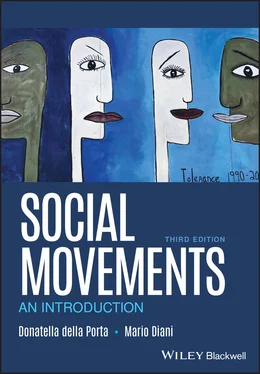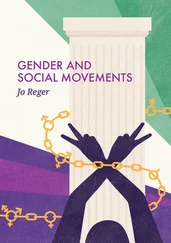However, it is unclear whether the link between the new middle class, new movements, and new types of conflict effectively demonstrates the existence of a specific structural base for these types of conflict. The presence en masse of the new middle class in protest movements could, in fact, simply reflect the traditional inclination of the intellectual middle class to participate in any type of conflict (Bagguley 1995a) given their greater confidence in their own rights and capacity to speak up and participate in political life (Bourdieu 1984). From this perspective, the reference to specific structural contradictions at the base of new conflicts somewhat loses consistency. It is, rather, the case that belonging to the middle class, on the one hand, facilitates the taking up of concerns that are generically favorable to public involvement; and on the other, puts at one’s disposal individual resources and competences that can be spent in various types of political action.
In effect, comparative analysis of political participation has revealed on numerous occasions that variables of a sociodemographic type tend to explain with equal efficacy both unconventional participation (particularly widespread among movement sympathizers and activists) and conventional participation. There is, for example, a strong correlation between two factors that are usually regarded as indicators of the new middle class – youth and a high level of education – and various types of political attitudes and/or political participation (Barnes et al. 1979; Opp 1989, Chapter 7; Norris 2002, 201 ff.). Intellectuals have traditionally constituted the leadership of ethnic movements (Smith 1981). Furthermore, a comparison of political ecology and more traditional environmentalist currents showed that activists from the new middle class were present in equal measure in both sectors, in spite of the difficulty to identify conservation groups as new social movements (Diani 1995, p. 58).
Rather than on peculiar class dynamics, the undeniable relationship between membership in the new middle class and involvement in some types of protest movements might well be dependent on yet other factors. For example, it might be the outcome of the enormous rise in access to higher education, which again originated in the 1960s. More specifically, higher education might not only provide people with distinctive intellectual skills; it might also foster the growth of an egalitarian and anti‐authoritarian set of values, which are overrepresented among at least some sectors of the new middle class (Rootes 1995). Alternatively, youth radicalism might be related to generational experiences, as the current members of the new middle classes have all been exposed to that particular combination of social conditions, consisting of the end of the Cold War and the spread to the middle classes of unprecedented economic prosperity (Pakulski 1995, p. 76). Or there might be lifecycle effects, as younger people’s political involvement might be dependent on their biographical availability, given their more uncertain status, their still unsettled professional life, and their greater independence from family and community linkages (Piven and Cloward 1992).
Moreover, the notion of middle class risks comprising quite heterogeneous social sectors: those who work in the sector of culture and personal services and those who fulfill managerial or other technocratic functions risk remaining unclear; the sectors of the new middle class that are closer to the problems of the management of organizations (managers) and those who, instead, draw their legitimacy and their status from being controllers of professional resources, independent of specific organizational structures (professionals) (Kriesi 1993, pp. 31–32). To evaluate appropriately the importance of the new middle class in social movements, it is useful, therefore, to differentiate between its internal components. Taking inspiration from Wright (1985), who regarded classes as defined by different combinations of “assets in the means of production, organizational assets and skills or credentials,” Hanspeter Kriesi identified the distinctive characteristic of the new middle class in the fact that it exercises some control over organizational resources and/or over professional skills, but does not possess the means of production (Kriesi 1993, p. 28; see also Kriesi 1989a). In particular, he suggested looking at three different sectors of the new middle class: alongside the “sociocultural specialists” are managers and those who fulfill clearly technical roles. This last group includes administrative and commercial personnel from public and private organizations, technical specialists – some highly qualified and others less so – and those working in “protective services” (the police, the army, civil protection organizations, and the like). Even the wave of anti‐austerity protests have been interpreted as “middle class” phenomena. In fact, mobilizations have been presented by some observers as a manifestation of “a new middle‐class politics – democratic, environmentalist – whose global import is predicted to grow” (Yörük and Yüksel 2014, p. 103).
The awareness of the various components of the new middle class and the critical evaluation of their impact on political participation, alongside that of those belonging to the traditional classes (the old middle class and the working class), help to interpret more accurately the relationship between class condition and (new) forms of participation. Analysis of environmentalist militancy (Cotgrove and Duff 1980; Jamison, Eyerman, and Cramer 1990; Dalton 1994, Chapter 5; Diani 1995) noted that those filling the highest positions in groups engaged in this kind of activity were not only highly educated and – in the broadest sense – members of the middle class, but also brought specific competences to bear on the work of the group. Analyses of the link between individual class location and political behavior have certainly brought to light a series of relevant characteristics of new forms of political participation. They have, in particular, provided important information about old and new social movement activists and sympathizers. In doing so, however, they have postulated a direct link between the structural position of individuals and collective action that is by no means clear‐cut. In fact, while it is possible to look at classes as aggregates of subjects who occupy analogous positions in the system of social stratification, in terms of the resources they control, the prestige they enjoy, and their social opportunities, this is not necessarily an appropriate strategy when dealing with the problem of collective action.
Alternatively, it is advisable to analyze classes as collective actors with a specific identity and self‐awareness, linked to other social groups by relationships of a cooperative or conflicting nature. In this perspective, class exists only in circumstances where people mutually recognize and are recognized as part of a distinctive social group, if specific interests and solidarity between the occupants of particular social positions have been identified, and if, on this basis, specific forms of collective action are to be promoted (Thompson 1963; Tilly 1978; Touraine 1981).
Conditions favoring the return of various forms of status politics seem to have been reproduced. In these, the central role is taken by social groups brought together by certain levels of prestige and specific moral codes (Turner 1988; Eder 1993). Telling against the more structural version of the middle‐class thesis, the attention paid by the middle class to its own group identity and positioning is certainly not a characteristic exclusive to recent mobilizations (Calhoun 1993). As the historical experience of the anti‐alcohol movement reminds us (Gusfield 1963), the middle class has distinguished itself over time by its continual attention to moral codes, socially acceptable rules of conduct, and principles defining the “good life.”
Читать дальше












